#SOUTH EAST CENTRAL RAILWAY
Text
Train Services to Be Disrupted in Bilaspur Division Amid Rail Work
Santragachi-Jabalpur Express and its return route will be cancelled in early September.
Train operations in the Bilaspur Division of South East Central Railway will experience disruptions due to ongoing developmental work.
JAMSHEDPUR – The South East Central Railway has announced the cancellation of several train services due to ongoing infrastructure work in its Bilaspur Division.
The 20828…
#20827 Jabalpur-Santragachi Express#20828 Santragachi-Jabalpur Express#जनजीवन#Bilaspur Division railway work#Indian Railways updates#Life#passenger advisories#Railway Infrastructure Development#Santragachi Jabalpur trains#South East Central Railway#train cancellations#train schedule changes
0 notes
Text

"SECR Recruitment 2024: 861 Apprentice Posts - Apply Now"
The South East Central Railway (SECR) has announced 861 Apprentice vacancies. To apply, candidates need a minimum qualification of 10th grade and ITI certification. The job location is Nagpur, Maharashtra, with a monthly pay scale of Rs. 7,700 to Rs. 8,050. Applications are open from April 10th to May 9th, 2024.
#South East Central Railway#SECR Recruitment#SECR Railway#South East Central Railway Zone#SECR apprentice
0 notes
Text
ज़रूरी सूचना, 2 दिन पटरी पर नहीं दौड़ेगी 3 ट्रेनें, रद्द की गई
बिलासपुर। दक्षिण पूर्व मध्य रेलवे के बिलासपुर मंडल ने कटनी लाइन में चलने वाली तीन ट्रेनों को रद्द कर दिया है. 4 और 11 जून को इन ट्रेनों को रद्द किया जा रहा है. जिन ट्रेनों को रद्द किया गया है वह गरीबों की ट्रेन कही जाती है. इसमें छोटे छोटे स्टेशनों के मुसाफिर यात्रा कर अपने रोजगार के साथ ही अन्य जरूरी काम करते हैं.
4 और 11 जून को शहडोल बधवाबारा, लोरहा चंदिया रोड स्टेशन के बीच समपार फाटक को…
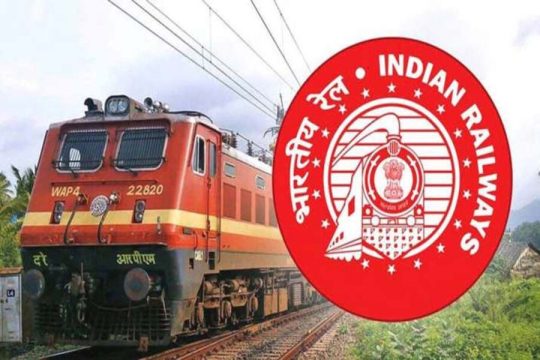
View On WordPress
#bilaspur#BILASPUR BIG NEWS#BILASPUR DIVISION#BILASPUR NEWS#BILASPUR RAIL DIVISION#Breaking Hindi News#indian railways#Latest News in Hindi#SOUTH EAST CENTRAL RAILWAY#Train cancelled list#videos#दक्षिण पूर्व मध्य रेलवे#बिलासपुर#बिलासपुर न्यूज़#बिलासपुर बिग न्यूज़#बिलासपुर मंडल#बिलासपुर रेल मंडल
0 notes
Text
861 Act Apprentice Position in South East Central Railway
Unlock a world of opportunity with South East Central Railway’s Act Apprentice positions! Ideal for candidates with ITI, 10th, or 12th qualifications, these coveted roles offer a gateway to a rewarding career in the railway sector. Nestled in the heart of Bilaspur, Chhattisgarh, South East Central Railway beckons aspiring apprentices to embark on a journey of learning and growth.
Eligibility…

View On WordPress
#employment news#Fresher Jobs#Fresher Jobs in Govt Organizations#Fresher Recruitment in Govt Organizations#Fresher Vacancy#Fresher Vacancy in Govt Organizations#government jobs#government jobs in india#government vacancy#govt jobs#govt vacancy#Jobs in South East Central Railway#Railway Jobs#railway recruitment#railway recruitment in india#Railway Vacancy#Recruitment in South East Central Railway#sarkari naukri in india#south east central railway employment#south east central railway jobs#south east central railway recruitment#south east central railway vacancy#Vacancy in South East Central Railway
0 notes
Text
South East Central Railway Recruitment 2023 Apply Online 1016 Assistant Loco Pilot, Technician, Engineer Vacancies
South East Central Railway Recruitment 2023 Notification of GDCE 01/2023: South East Central Railway (SECR), Railway Recruitment Board, Bilaspur invites online applications from regular and eligible employees (except RPF / RPSF) of SECR for filling up following Assistant Loco Pilot, Technician and Junior Engineer posts against General Departmental Competitive Examination (GDCE) Quota. The SECR…
View On WordPress
#1016#2023#apply#assistant#central#east#engineer#loco#online#pilot#railway#Recruitment#south#technician#uncategorized#Vacancies
0 notes
Note
I am sliding into your inbox to ask you about historically multicultural australia 👀 what’s one fact/event/etc no one’s asked about yet that you think makes a good story?
I have a million and one ideas for things that no one has asked about that i think are terribly underrated. But I'll roll with a definitely not unknown, but definitely brushed over, simple answer of the topic of "afghan cameleers" in Australia.
While theyre often called "Afghan" in Australian history, they actually came from a variety of countries throughout the Middle East and south Asia. They were predomanently Muslim men, some bringing their families, although other religious minorities did also exist.
The Cameleers, (and their camels) were first brought over to Australia in 1838, although in no form of high numbers until 1858 when they were involved in the Bourke and Wills exploration of the east coast states. As a British colony, there were various high level people in Australia who were aware (from interactions with India and the Middle East primarily) of the benefits of camels in dealing with desert climates.
For over 50 years, camel trains became the primary form of transporting pastoral goods across much of the rural parts of Australia, at the hands of very experienced Cameleers. As a result of this, there was historically a number of towns which became known as "little Asia"s, "little Afghanistan"s or "Ghantowns".
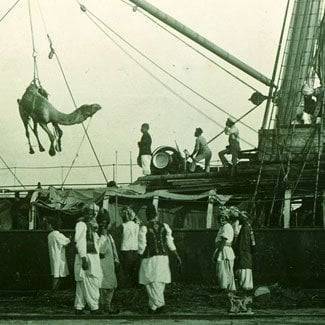
Many of these men are coming to be recognised in modern times as fundamental actors in Australia's modern history. They also married Aboriginal, Chinese, or European women, and often, despite racial and cultural descrimination, became well respected members of local towns, playing important roles in their developments. Many of the men continued to travel back and forth from their home-countries, conducting business on an international scale. At the peak of employment, it is believed that 2000-4000 cameleers were employed in Australia, however recording of this immigration at this time is limited, and it is possible the numbers may have been higher.
However, when Australia introduced the Immigration Restriction Act 1901 (otherwise known as the "White Australia Policy"), many of these men found they were unable to become naturalised citizens of the newly-federated country, and thus unable to return to the communities (and families) that had become their homes. The remaining "afghan" communities dwindled after this. With the increase of railway access to Australia, the need for skilled cameleers died out, and the once valued workers became subject to a lack of employment, and increasing government and community persecution. Much of the men that remained into this time chose to return to their home-countries.
However, some communities remained. The town of Marree in South Australia is the location of the first Mosque in Australia, and is recognised as the longest surviving "Ghan-town" community, and the location of many descendant families. These workers, and their descendants, are also responsible for the construction of Australia's oldest permanent mosque, the Central Adelaide Mosque.

In recent times Australia is beginning to acknowledge important role these men made in the country's modern history, although they are subject to limited discussion, research, and archaeological recognition. And there is still a way to go, especially in making sure that the surviving archaeological sites relating to these communities and workers aren't lost.
#this was such a fun ask#even if it took me forever to get to it#If anyone wants actual references lmk#or just info in general#i wrote most of it from memory so I'll have to go find where my files are saved#but somewhere i have books and journal articles and stuff saved#the benefits of writing a thesis on multicultural heritage#i swear i have sources on everything#in a disorganised file#somewhere#history#Australia#mice answers things#archaeology#they let a mouse do archaeology?
51 notes
·
View notes
Text
Linkon Subway: Line 11
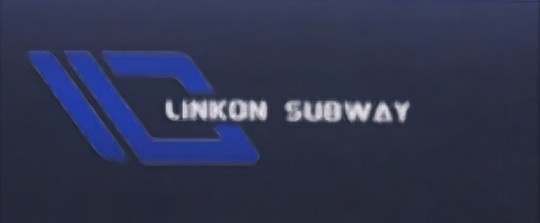
Organization Name: Linkon Metro Supervision Service
Website: www.linkonsupervision.ccm
The Linkon Subway is a frequent mode of transportation showcased throughout the game. The in-game world has a vast system of railway lines, stations, and terminals throughout the Linkon City area.
Line 11 of the subway runs from the Coelum Express Terminal to the Linkon Botanical Garden, it's first availability is at 5:00 AM and it's last stop is at 11:55 PM.
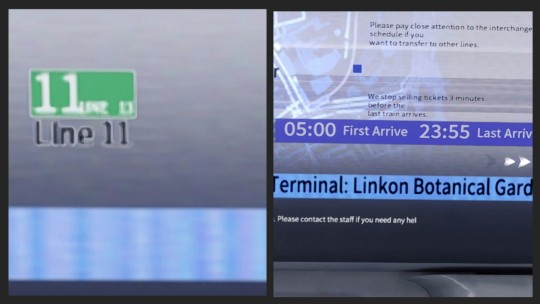
Warnings & Signage:
Here are all of the legible signage/information I spotted on the subway. Overall, it seems to be a very accommodating service!
"Please do not get on or off the vehicle when the door light is flashing"
"Disabled-friendly carriage is available. Please contact the staff if you need any help"
"Please pay close attention to the interchange schedule if you want to transfer to other lines."
"We stop selling tickets three minutes before the last train arrives."
Details:
The specific subway the protaganist boards in "Late Night Encounter" is subway 18. She mentions it's a subway she takes every day. That particular night, she boarded the train from the Garden West Station. At the time, it's announced as the last subway to Linkon Botanical Garden that night.

When the subway circles back to the same departing station again, the opened doors show a glimpse of signage listing the other stops along Line 11. It lines up with the known terminals of this line as well as the next stop shown on the display. The only mismatch is the sign shows the stop before Garden West as "Newtown Avenue" while the internal subway display says it was "Metro Boulevard". The text is pretty hard to make out, but I'll list what I've deciphered so far:


In descending order, it lists:
Linkon Botanical Garden
South (?) (?)
Ch(?) Town
Linkon South Station
(?) Highway [if I squint, it kinda looks like "Alkaline"?]
(?) (?) (?) Park [kinda looks like "Estate World Theme Park"?]
(Jiajang?) (?) (?)
Linkon No. 3 (?)
Pioneer Village
(Bohee?) Tech Park
Garden East
International Exhibition Hall
Garden West [the station where protaganist boarded]
Newtown Avenue
Linkon Library
University of Linkon
Commerce Harbor
(?) [the first word kinda looks like "Public" and the last word looks like "Center"?]
Moonrise St.
River Bridge
Jayden North
Duke's Bay
Cloud Train Terminal (likely an unintended artifact before the name "Coelum Express" was finalized?)
After defeating the Wanderer, the subway station they exit from has another sign identifying Line 11 and a sign indicating the following locations are nearby:
Garden West
Central Park
Century Center
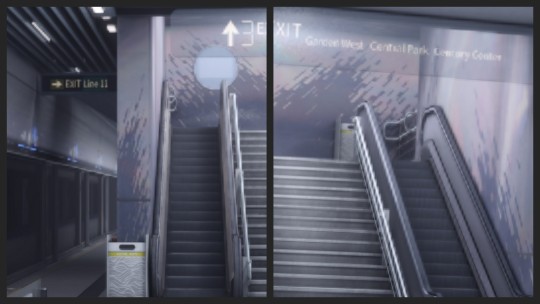
Other Linkon Subway Lines:
In a few scenes, we get a glimpse at the map of subway lines. I was unable to gather any useful details from it. But if you spot something, pls holler lol.
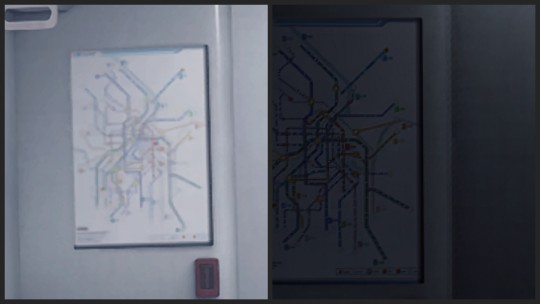
Funny Details:
If you look closely, you can spot a couple of misspellings in the signage:
Instead of "Next Stop", the display reads "Nest Stop"
In the message about disability carriages, it tells you to contact the staff if you "need any hel"

#love and deepspace#lads#lads linkon city#linkon city#love and deepspace trains#lads trains#love and deepspace subway#lads subway
18 notes
·
View notes
Text
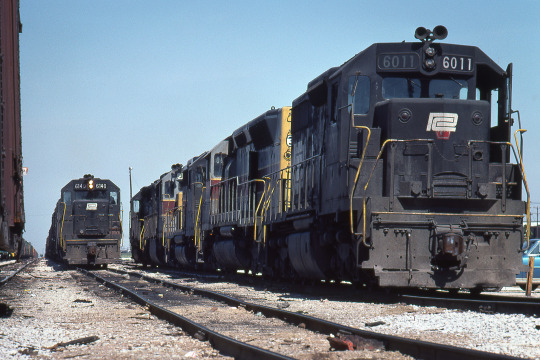
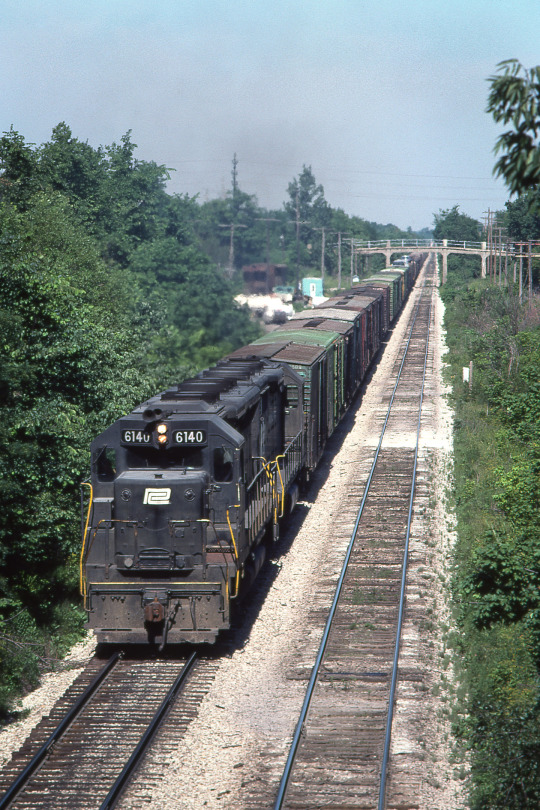
Westbound from Avon
The first image here shows a westbound train ready to depart Avon Yard (in the distance, on the left hand side of the frame). We're on the former Big Four/NYC west of Indianapolis.
Conrail is two months old when these pictures were taken so the power standing off to the side is interesting—three units of the Erie Lackawanna along with a Penn Central unit with a Pennsy logo peeking out. Two of three EL units (SD45-2 and SDP45) were purchased with the idea of having larger fuel capacity for long runs from the east to Chicago without refueling.
The second image has the train down the line about six miles, directly south of Danville, Indiana. We're looking down on the railway from State Road 39.
Two images by Richard Koenig; taken June 5, 1976.
#railroadhistory#railwayhistory#penncentral#conrail#erielackawanna#sdp45#sd45-2#danvilleindiana#avonindiana#avonyard#bigfour#newyorkcentral
65 notes
·
View notes
Text



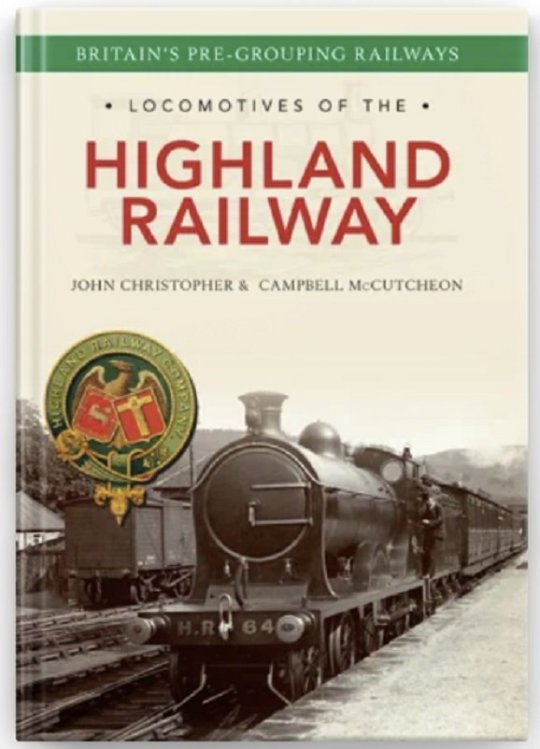

On February 1st 1865 the Highland Railway was formed from the amalgamation of Inverness and Perth Junction and the Inverness and Aberdeen Junction Railways.
Back in the day every region had it’s own local railway company covering the different areas around the country. The Highland Railway ran from Perth in Central Scotland north to Inverness and then on up the east coast to Wick and Thurso. From Dingwall, the railway ran west to Kyle of Lochalsh to serve Skye and the Western Isles. From Inverness, another line ran east to Keith, where it connected with the line to Aberdeen. Several branches were built from this core network to serve nearby towns.
This is a longer post than I normally put together but hope you get an idea of how all these wee companies ran, and ended up becoming the one company, before of course the bigger companies ate them all up. Some of the stations are now gone, but others mentioned, like Kingussie, Nairn, Keith and Dunkeld survive to this day, and I often pass through them on my travels north. It also gives us an insight intothe infamous Beeching cuts in the 60’s which butchered the rail network, if Beeching had his way there would be no railways beyond Inverness!!
Inverness was always the centre of the Highland Railway. It was the company’s headquarters and principle station. All trains led to Inverness.
The original proposals to construct railways to Inverness were made in the mid-1840s. Rival routes were proposed from Perth and Aberdeen . The Perth & Inverness Railway was considered too hilly for the locomotives of the day, but the Great North of Scotland Railway (GNSR) from Aberdeen was authorised. The GNSR struggled to raise capital in the post-railway mania period and eventually started construction as far as Huntly in 1852, opening that line in 1854.
The people of Inverness then stepped in and started building their own line from the Inverness end, initially as far as Nairn, the Inverness & Nairn Railway (I&N) was opened on 6th. November 1855 but by then plans were being made to extend this railway to meet the GNSR. After some discussion, the Inverness & Aberdeen Junction Railway (I&AJ) was promoted to build the line from Nairn to Keith where it met the GNSR extension from Huntly. The I&AJ was completed on 18th. August 1858,when it took over the working of the I&N.
The people of Inverness were never satisfied with the long journey round via Aberdeen , especially as the GNSR’s station was half a mile from that of the line from the south and connections were not always maintained. Thus was born the Inverness and Perth Junction Railway (I&PJR) which ran from Forres via Grantown, Kingussie and Drumochter summit to Dunkeld where it met with end on with the Perth and Dunkeld Railway which had opened in 1856. The I&P was authorised in 1861 and opened just two years later, being worked from the outset by the I&AJR. The two companies amalgamated on 1st. February 1865 to form the Highland Railway.
Meanwhile construction northwards from Inverness had already started, with a line to Dingwall (1862), Invergordon (1863), Bonar Bridge (1864), Golspie (1868), Helmsdale (1871) and Wick and Thurso (1874). Westward from Dingwall, the Dingwall & Skye Railway was opened to Strome Ferry in 1870.
In the 1890s, two additions were made to the main network. The direct line from Aviemore over Slochd to Inverness was completed in 1898, a year after the Skye line was extended to the present terminus at Kyle of Lochalsh. Several branches were opened from these main lines over the next 40 years, taking the final length of the system to some 242 route miles.Tourist traffic has always been a major source of income for the railways in the Highlands . The Highland Railway developed its own hotels at Inverness , Dornoch and Strathpeffer. It offered combined tours in conjunction with the steamer services of David MacBrayne. Each August it had to contend with the annual migration north for the ‘glorious twelfth.’
The railway played a major part in the First World War, when the Grand Fleet was stationed at Scapa Flow in the Orkney Islands . Worn down, like many other railways in the country, it became part of the London , Midland and Scottish Railway in 1923. The LMS continued to develop the lines, introducing dining cars and speeding up services. The Second World War again imposed a considerable strain on the lines.
On the nationalisation of the railways, the Scottish Region of British Railways took over. Soon the development of road transport made a significant impact on the use of the railway. The closure of branch lines, which had started in the 1930s, continued. The Beeching Plan of 1963 envisaged the closure of all lines north of Inverness , but this was not approved because those lines still provided a lifeline in winter. The old route from Aviemore to Forres and a number of intermediate stations on the main lines, were closed. Otherwise the main system remained intact, as it does today. Currently operated by ScotRail, the lines continue to provide a vital link to locals and bring many tourists to the area.
The Highland Railway was well known for its locomotives. Working the steep gradients of the main line, in particular, was always a challenge. Add strong winds and snow and the problems became even worse. The railway introduced the first 4-6-0s to the British Isles, commemorated in the preserved No.103 at the Glasgow Transport Museum . In the 1930s, the LMS Black 5s, locally always called “Hikers”, immediately proved their worth. The isolated nature of the country led British Railways to implement complete dieselisation early in the modernisation plan.
Today class 158 and 170 diesel multiple units work most of the trains, but you can still retire to bed in a sleeper on the line out of London Euston and wake up to the sound of a Class 67 struggling up Drumochter.
39 notes
·
View notes
Text
if I was to become world dictator, my stupid vanity project would be a railway that goes across the entire world
South America through Central America, up to Alaska, across to Russia, connecting to Asian and European rail grids, across the middle east to Egypt, going all throughout Africa
would it be unimaginably expensive? yes
would it be an ecological nightmare? probably
would it be cool? also yes
14 notes
·
View notes
Text
SECR Announces Major Train Schedule Overhaul
Development Works Trigger Widespread Cancellations and Diversions
South East Central Railway’s extensive development works disrupt multiple train services, affecting passengers from September 10-28, 2024.
JAMSHEDPUR – South East Central Railway (SECR) unveils comprehensive train schedule modifications due to ongoing infrastructure enhancements spanning September 10-28, 2024.
The SECR’s ambitious…
#Azad Hind Express reroute#जनजीवन#diverted train routes#Howrah-CSMT Mumbai Mail diversion#Indian Railways infrastructure upgrades#Life#MEMU special short termination#railway development works#SECR train cancellations#September 2024 railway changes#South East Central Railway updates#Tatanagar-Bilaspur Express
0 notes
Text

SECR 2024 Recruitment: 733 Apprentices Posts - Apply Now
South East Central Railway has recently announced 733 vacancies for Apprentices. Eligibility criteria include completing 10+2 and holding an ITI certification. The job location is in Bilaspur, Chhattisgarh. The pay scale is as per norms. Applications began on March 12, 2024, and will close on April 12, 2024. No payment is required for applying. Don't miss this opportunity! Apply now.
0 notes
Note
Sorry to correct you but. Samosa is an indian dish not Kenyan
Hello anon! LOL okay I never expected to get into Samosa Discourse on my Star Trek blog but I happen to love food and history and the history of food so here we go😂
You are correct that samosas are not native to Kenya- and yes, India is by far the country most associated with samosas in the popular imagination (for good reason, samosas are pretty much omnipresent throughout India!) But while samosas are not originally from Kenya, that doesn't mean (imo at least) that they cannot be counted as part of Kenyan cuisine. (Which I didn't even necessarily do in that post, but I understand your position so I'll elaborate on those terms!)
Kenya is a multi-ethic country made up of several African peoples and migrant communities, including Kenyan Asians. Now, the history of South Asians living in/trading with East Africa goes back centuries, but there was also this huge (and deeply colonial) boom in the Asian population during the late 1800s-early 1900s when the British sent tens of thousands of indentured Indian labourers to Kenya to build the Uganda railway. (There is a LOT more history I could get into re the British East Africa Protectorate and the complicated social dynamics between African & Asian communities at the time, but that's not really relevant to samosas so I'll spare you.)
Anyway, modern day Kenya still has a considerable South Asian population, and as such (again not getting into the more complicated social dynamics here), Kenyan cuisine has a lot of Indian (and Arab) influences. But beyond that- Swahili culture(s) and cuisine(s) evolved over centuries of interaction between the various (predominantly Bantu) peoples of East Africa and traders from West, Central & South Asia (who brought in- among other things- their own spices), so cultural intermingling has always been a staple of the East African coast (which is geographically SO close to Asia!) If you were to walk around some of the bigger, more Asian diaspora-heavy cities of Kenya, like Mombasa or Nairobi, you'd find plenty of chicken/fish-based coconut curries & stews that strongly resemble Indian ones- as well as rice-based dishes like pilau & biriyani, rotis, chapatis, bhajias (called 'bajjis' in certain parts of India), kheemas, kebabs- and yes, samosas. Or sambusas, as they're often called in Kenya.
And what's more- the samosa (originally 'samsa' iirc) likely originated in Central Asia in the first place! It still goes by other names in West Asia and North Africa too; as do several other dishes-in-common. In fact, kuku paka (a dish I mentioned in the post that prompted this ask) is a Kenyan chicken curry with distinct Indian & Arabic influences. So if samosas can qualify as Indian cuisine (which, they undoubtedly do), imo they can qualify as a part of Kenyan cuisine too! Anyway I'm truly sorry I let this ask get SO far away from me lmao, I guess I've always felt a bit alienated by this growing tendency in Asian & African communities to sort of rigidly and unquestioningly (even proudly) uphold colonial divides when our cultures are actually so sprawling and ancient? Like sure, we are not monoliths, and it is important that people learn that- but also, so many political borders across both continents didn't even exist as they are today even a hundred years ago. It's so cool how much there is in common! Food, like so many other aspects of culture, is often migratory and full of varied influences, and that's just so deeply human and beautiful and fascinating to me
#nebulouscoffee on tumblr: come for the trekposting stay for the samosa lore apparently? lol#apologies to anyone who actually read all this rambly nonsense wish I could give you a sambusa/samosa as a reward#also anon I know you meant well and TRULY no hard feelings so pls don't take this the wrong way but. this ask made me giggle#I don't know if you're indian or just a concerned (white) citizen but speculating actually cheered me up on a Trying night so thank you!#in either case: you needn't worry!! I'm not out here on a mission to spread samosa misinformation on my star trek blog peace and loveee#(in all seriousness I'm very sorry if this reply came off as condescending or dismissive I promise it wasn't at all meant that way)#((might delete later btw just putting that out there))
15 notes
·
View notes
Note
In Newsies Jack talks about taking a train to Santa Fe, New Mexico. I was wondering if there was a train that connected New York and New Mexico in 1899? Would you need to get off the train at a certain point and get another means of transport? I'm sorry if this isn't a very good question but I'm curious lol.
I’ve been on an unintentional hiatus for about two years at this point, so I apologize for how long it’s taken me to get to your question, but I finally felt motivated to clear out my inbox on this blog and start answering questions again so I thought I’d give yours a go!
First of all, there are no such thing as bad questions! Personally, I think your question is an excellent one, and there are a couple of different answers to it.
The short answer to your question is that no, in 1899 there was not a direct train line running from New York City to Santa Fe, New Mexico. The long answer, however, is a bit more complicated.
The railroad that Jack would have had to travel on to reach Santa Fe was called the Atchison, Topeka, and Santa Fe Railway, but it was more commonly referred to simply as “the Santa Fe.” It was originally chartered in 1859 to serve Atchison, Kansas, Topeka, Kansas, and Santa Fe, New Mexico. After a bit of a rocky start (involving spies, silver mines, and robber barons), it became extremely successful, and was particularly well-known for its passenger trains.

(This is a photograph of a passenger train running on the Santa Fe railway sometime around 1895, likely the type of train Jack would have taken had he gone to Santa Fe after the strike. Note the Pullman cars!)
However, despite both the railway’s name and the original intention to build a railroad to Santa Fe, due to challenges with the elevation of the area the railway was originally forced to bypass Santa Fe completely and instead build a stop in nearby Lamy, New Mexico. However, in 1880 a spur track connecting Lamy to Santa Fe opened, ensuring that Santa Fe would be connected to the rest of the railway.
A map of the Santa Fe Railway from 1883 shows that the line only ran directly as far east as the Kansas-Missouri border. However, an updated map from 1899 shows that the direct line had extended all the way up to Chicago, meaning that someone could travel from Chicago to Santa Fe with much more ease than before. However, the line does not appear to have extended further east than Chicago at that time, meaning that in order to get to Santa Fe Jack would have had to first take a train from New York to Chicago.
Luckily for Jack, Chicago and New York have historically been connected since the 1850s by what is known as an east-west railroad corridor, with Chicago being the western endpoint and New York being the eastern. In 1899 there were four different railroads with lines connecting the two, but one of the most well-known (and the one Jack probably would have taken) was the New York Central Railroad’s line, on the Lake Shore and Michigan Southern Railway.
One very important thing to note about all of this, however, is that taking a transcontinental train in the 1890s was not exactly the same experience as it would be today. Jack, likely travelling in third class, would have probably had to sit on hard wooden benches for most of the trip (not the most comfortable experience). In addition, while as I said there was absolutely a way for him to get to Santa Fe from New York on a train, he would have had to change trains at least two or three times along the way (possibly more) due to having to switch between railway lines. It would have been a very long, somewhat expensive, and probably exhausting trip, although it’s one that Jack was clearly willing to make.
TLDR; Yes, Jack could have traveled from New York to Santa Fe taking only trains, without having to use any other type of transportation, however he would have had to switch trains several times over the course of his journey and make stops in many different cities and towns across the Midwest and Southwest of the United States.
Thank you so much for your question! I hope I answered it to your satisfaction. Stay tuned as I answer more, and also make a (hopefully exciting) announcement about the future of this blog later on!
Sources:
https://www.loc.gov/item/98688579/
https://www.loc.gov/resource/g3701p.rr003250/
https://www.nps.gov/safe/learn/historyculture/map-timeline-5.htm#:~:text=The%20first%20Santa%20Fe%20railroad,now%20be%20traversed%20by%20rail.
https://www.smithsonianmag.com/history/santa-fe-railroad-changed-america-forever-180977952/
https://en.wikipedia.org/wiki/Railroads_connecting_New_York_City_and_Chicago
13 notes
·
View notes
Text
Nestaway’s Insider Guide: Top 4 Family-Friendly Neighbourhoods in Chennai
Chennai, often dubbed the "Gateway to South India," is a city where history and modernity coexist in perfect harmony. It is a city that provides citizens with a good quality of life because of its rich cultural heritage, elegant temples, and perfect beaches. If you and your family are thinking of relocating to Chennai, there are a number of important things to take into account when renting accommodations through the Nestaway platform. Apartment rentals in Chennai are impacted by their location, connectivity, and security. Using the Nestaway good platform, you can choose a family-friendly property in Chennai in an area that exactly aligns with your needs. These areas give close access to prestigious schools in addition to accommodating your job convenience. You can securely explore these localities for your Chennai house rental with Nestaway, ensuring a smooth transition.

Adyar
Adyar is a serene residential neighborhood located along the southeastern coast of Chennai, bordering the Bay of Bengal. Adyar is well-connected to major roads like the East Coast Road and Old Mahabalipuram Road, ensuring smooth travel within Chennai. Adyar is reachable via the city's suburban rail network due to the presence of its own MRTS railway station. This place is home to a number of reputable schools, notably the Bala Vidya Mandir Senior Secondary School, and Abacus Montessori School. Also, this locality is an appealing choice for professionals in the IT industry due to its closeness to the OMR IT corridor and Tidel Park. Furthermore, its proximity to the Adyar River and the Theosophical Society increases its appeal. Adyar is renowned for its safety. With a strong sense of community and well-guarded streets, it offers families a safe environment. Being a reliable source, the Nestaway platform can help you learn about Adyar’s residential and educational advantages, making it a good fit for your family's requirements.
Anna Nagar
A well-planned residential neighborhood, Anna Nagar is located in Chennai's northwest. Ambattur and Guindy Industrial Estate, Chennai's well-known job hubs, are easily accessible from this region because of the area’s outstanding connectivity to major routes such as Anna Arch flyover and the Inner Ring Road. Additionally, as displayed on the Nestaway reliable platform, Anna Nagar residents enjoy easy access to prestigious educational institutions, including SBOA Matriculation and Chinmaya Vidyalaya. The neighborhood also boasts of having its own metro station, which provides easy access to other parts of the city. Moreover, Anna Nagar is regarded as one of Chennai's safest areas, with well-lit streets and a vibrant neighborhood. You can trust its safe and secure environment.
Velachery
Velachery, in South Chennai, is the biggest commercial center in this region of the city and is a booming center for both business and residence. This neighborhood holds distinction from other rental localities in Chennai because of its affordability and well-known transit system, which includes Velachery Main Road and the Inner Ring Road. This benefit is further enhanced by Nestaway. This region is a great alternative for professionals because it is in proximity to well-known IT parks, like Tidel Park and Ascendas IT Park. This area is also renowned for having some of the best educational facilities, including The Ashram Matriculation Higher Senior Secondary and D.A.V. Public School.

Mylapore
Mylapore, as highlighted through the reliable Nestaway platform is a locality located in the heart of Chennai. It is a very historic and culturally significant neighborhood. Mylapore has great access to well-developed roads, in addition to its proximity to major transport hubs like Chennai Central railway station. Some of the best educational institutes, including Lady Sivaswami Ayyar Girls' School and Vidya Mandir Senior Secondary School, are easily accessible in this locality. The city's primary commercial areas and workplaces are also well connected to Mylapore. The Nestaway reliable platform ensures that you can learn about the many beneficial features of the locality and can book affordable accommodation here.
Conclusion
Chennai serves as a vibrant example of the evolving urban landscape of India with its rich cultural legacy, modern infrastructure, and diverse people. This dynamic city beautifully blends history and innovation, providing its people with a comfortable life. By relying on Nestaway's good ratings and Nestaway reviews, you can comfortably make well-informed financial decisions in Chennai's growing rental real estate market, where families often relocate for greater opportunities. It doesn't matter if you are a student or a working professional; Chennai will take care of your needs. As a student or a working professional, Nestaway will assess your rental and other costs. With the help of the Nestaway platform, you can estimate your rental costs while taking your particular needs into account. You have a choice of a plethora of options that are also pocket-friendly. It also facilitates a variety of rentable processes that enable accommodation in Chennai. Nestaway is backed by a variety of positive Nestaway review and Nestaway ratings.
#nestaway#nestaway ratings#nestawayreview#nestawaygood#nestaway platform#nestaway reliable#nestaway reviews#nestaway good#nestawaypune#nestaway review
4 notes
·
View notes
Text
Van Buren Street Station, Chicago
1896, Francis T. Bacon, Supervising Architect of the Illinois Central Railroad system
John F. Wallace, Chief Engineer
J.L. Fulton Company, General Contractors

Van Buren Street Station, platform level view
The Van Buren Street Station, 132 E. Van Buren at Michigan Avenue, is a commuter rail station in downtown Chicago serving the southbound Metra Electric Line, as well as the South Shore Line to Gary and South Bend, Indana.. It is the oldest active station building on the Metra Electric line. The station is located in Grant Park to the east of Michigan Avenue at Van Buren Street.
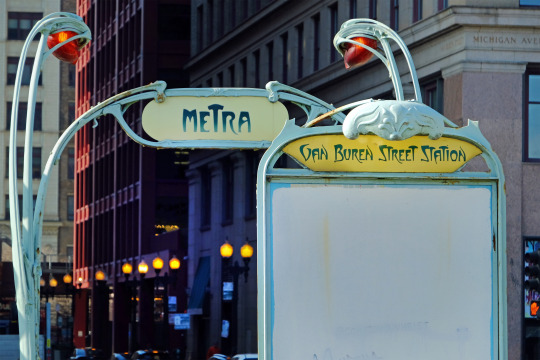
One of the station's entrances is a replica of an Hector Guimard-designed, Art Nouveau-style Paris Métro entrance. The entrance was given to Chicago as a gift by the city of Paris in 2001. The Guimard entrance will be relocated as part of a station renovation to be completed by 2027.
The station was originally constructed by the Illinois Central Railroad (incorporated 1836; operated independently until 1972), and completed in 1896.

Vintage view of the station, with buildings of Michigan Avenue behind.
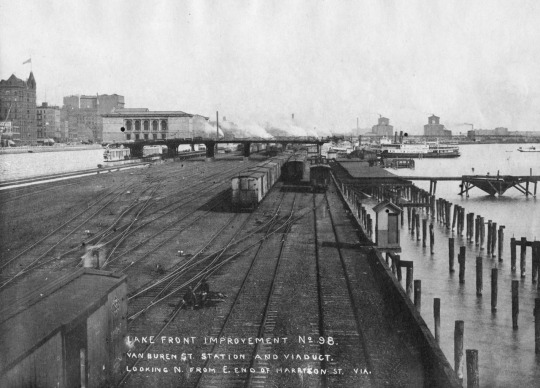
"Lake Front Improvement No. 98. Van Buren St. Station and Viaduct. Looking N. from E. end Harrison St. viaduct."
The Van Buren Station is the first Metra stop south of the Millenium Station, the northern terminus of the South Shore Line.
The station is completely invisible from the street, constructed below grade, one level below Grant Park. From Michigan Avenue, passengers descend stairs to a long, featureless tunnel about a block long, which splits into up and down ramps that easily confuse the visitor, and are inadequately labeled for the ticket office and main level, or down toward Platform 2 access.
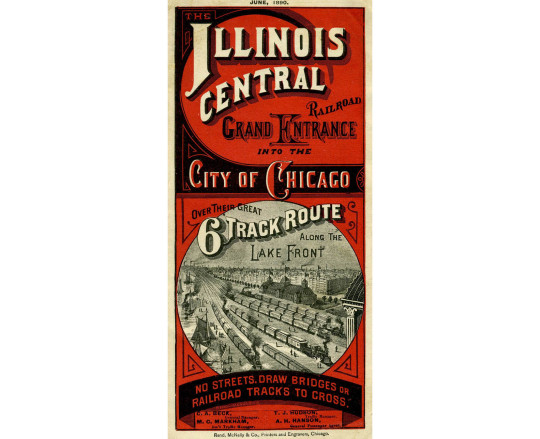
I saw the Van Buren Street Station for the first time when I took a train to Hyde Park, and decided not to depart from Millenium Station, which can be a confusing space to navigate. Nothing prepared me for this underground slice of history, and its largely intact tile and terra cotta waiting areas.

The station is below the level of the park, only its roof surrounded by a balustrade visible from above. The pedestrian viaduct over its center leads to the eastern side of Grant Park and the Lincoln statue. Entrances are from the sidewalk on the west side of Michigan Avenue, and from the Guimard Paris metro and stairs at "Van Buren Entrance" in the screencap above.

The station's placement is illustrated in the above plan, in The Inland Architect and News Record, Vol. XXIX No. 1, February 1897, Special Supplement p. 2.

The station's plan (above) and section (below) were also reproduced in the 1897 Inland Architect.
"Francis T. Bacon was the supervising architect of the Illinois Central Railroad system from the mid-1890s until 1907. Bacon died in Chicago on June 18, 1909, at the age of 43, after having been in private practice for two years." - Wikipedia entry
The Engineering Record, Building Record and Sanitary Engineer, Volume 60, 1909, cited in the wikipedia entry, doesn't reveal any further details of his life.

In this section, the station wall is heavily buttressed on the left, under the ground of Grant Park. A balustrade surrounds the ground-level roof, and the train platform is at right.
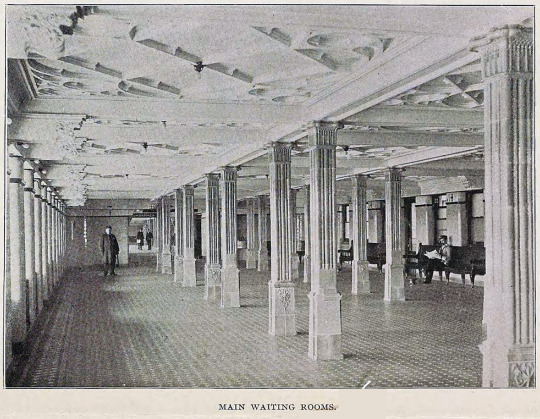
A glowing contemporary description of the station from The Inland Architect details the Waiting rooms' features and construction materials:
After passing the ticket inspectors, those taking express trains turn to the right and those for local trains to the left, in the central distributing corridor. From this corridor the passengers are ushered into two magnificent waiting rooms, each 34 feet by 106 feet and 9 ½ feet high. These rooms, for beauty, substantiality and completeness of appointments and conveniences, will compare favorably with those of any railway station in the world, even though naturally restricted in height of ceiling. The floors of the wating and toilet rooms, also corridor, are all paved with English floor tile; the foyer, vestibule and south entrance are paved with ceramic mosaic, and the bas throughout is of polished Tennessee marble. The walls are faced with Maw’s écru glazed tile, 3 by 6 inches, patented lock back, and the ceilings are of cast plates of stucco, forming a design of Gothic tracery. The cornices and girders and also finished in stucco, the point of junction with the glazed tile walls being covered with a mahogany molding. There are two rows of cast-iron columns in each room, which are incased in écru glazed terra cotta, elaborately molded and ornamented.
The windows of the ticket offices are covered with elaborate, handmade, wrought-iron grilles, some of which are polished and electroplated with bronze.
Source: The Inland Architect and News Record, Vol. XXIX No. 1, February 1897, Special Supplement p. 2

The station originally featured, apart from two waiting rooms, smoking rooms, a ladies' retiring room and lavatory, and a matron's room at the south end of the building.
The men's lavatory, bootblacking stand, toilet and janitor rooms are at the north end. There are also private lavatories for the attendants and locker rooms for the railroad employees. All these are under the space of 14 feet wide and 300 feet along the park side, and already occupied by the entrances, and are lighted through ceilings of cast iron and glass.
Source: The Inland Architect and News Record, Vol. XXIX No. 1, February 1897, Special Supplement p. 2
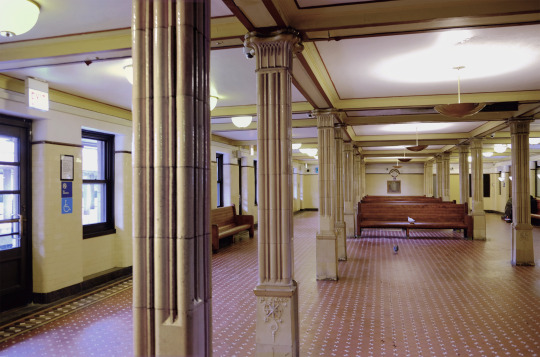
The tiles on the walls were manufactured by Maw & Co., of Shropshire, England, and are supplied and set by their agents, Hawes & Dodd, of this city, and are chiefly remarkable for their evenness of color, highly finished glaze, and freedom from the technical fault known as "Crazing."
Source: The Inland Architect and News Record, Vol. XXIX No. 1, February 1897, Special Supplement p. 2
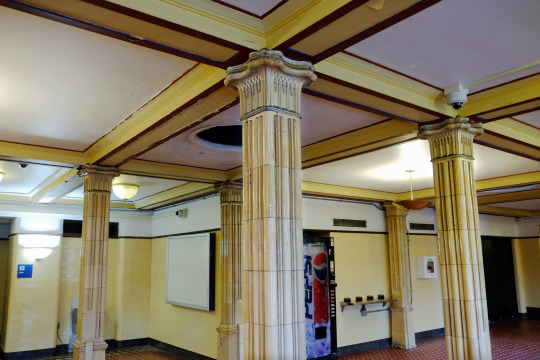
The Inland Architect article also noted the building's fireproof construction, including terra-cotta-clad iron columns, and that the entire interior was washable.
Not all of the station's original features remain. The cast-plaster ornamental ceiling is long gone, as are some of the more elaborate decorative elements, such as scrolled wall brackets and an ornamental drinking fountain shown in a period photo below.

No trace remains of the original marble and bronze recessed drinking fountains or decorative brackets above.

The column bases and bright inlaid flooring, in need of some restoration, are still in place.

The tilework remains intact, but the original ornamental ceiling has been replaced, as well as some other decorative elements.

Original mahogany waiting-room furniture includes this curved corner bench. The benches have brass feet, to facilitate cleaning the floors.

Detail of ornamental floor tile work at the edge of one waiting room

The ticket windows are located in the entrance vestibule leading to the twin waiting rooms.

Van Buren Street Station in 1907; exit stairs from middle platform to the Van Buren viaduct

"The east front of the building, 300 feet in length, shows a wall of one story, faced with cut Bedford stone - pierced with windows and doors." (Inland Architect)
The original awning over the platform was replaced, and is in a state of disrepair.
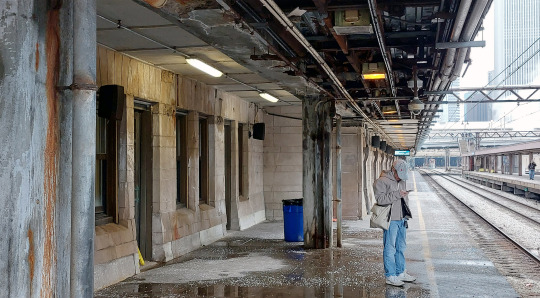
The recessed central area of the platform is directly underneath the Van Buren viaduct above.

The exterior still features carved stone decorations.
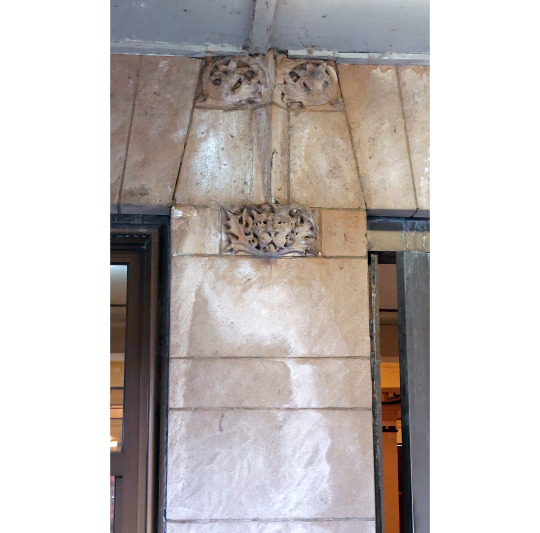
Detail of one of the carved stone elements.

"...even the copper down-spouts and their open heads are veritable works of art." ( Inland Architect)

At the far north end of the second platform, stairs allow passengers to exit to the Jackson Blvd. overpass, just south of the Art Institute.
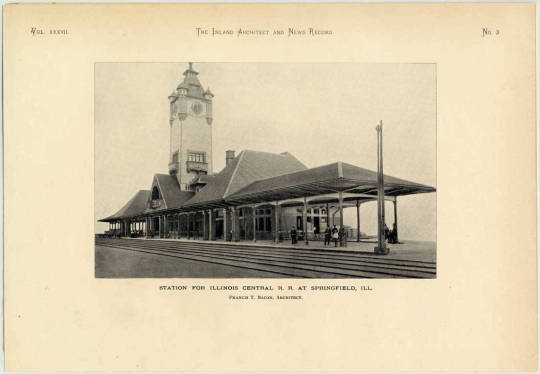
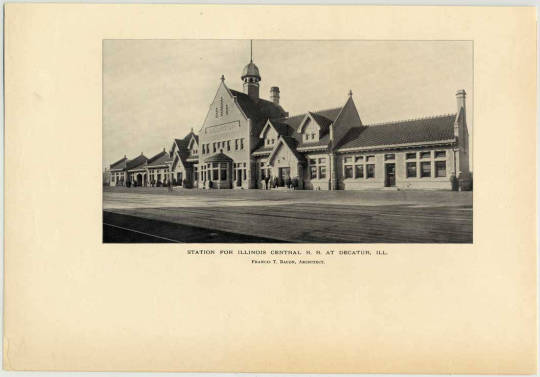
Other Illinois stations designed by Francis T. Bacon:
Left:
Illinois Central (IC) Railroad Station, Springfield, Illinois; Springfield Union Station, 500 E. Madison St., 1896-98; 1901 view, The Inland Architect
Right:
Illinois Central (IC) Railroad Station, Decatur, Illinois, c. 1890s; View 1901, The Inland Architect

The center or second platform gives access to northbound trains. It's reached by stairs or elevator below the main station.

Click here for a PDF version of The Inland Architect v 29 no 1 of Feb. 1897 article on the Van Buren Station.
Links:
7 notes
·
View notes